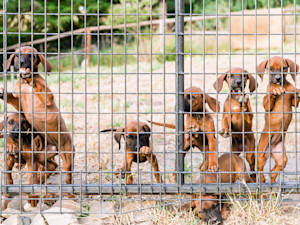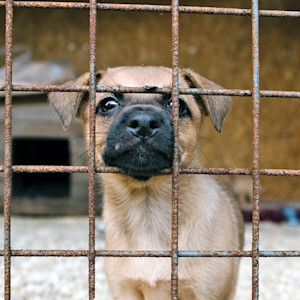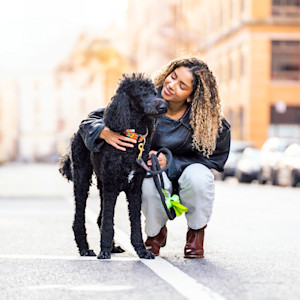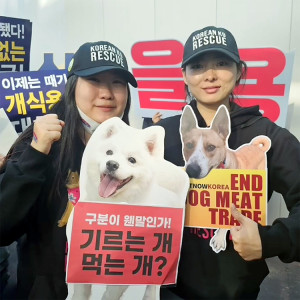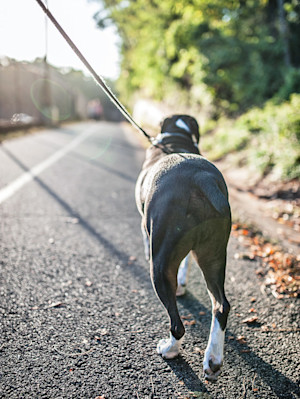What Happens When a Dog Attacks Another Dog? A Look Into “Dangerous Dog” Laws
After Penny, a Chihuahua mix, was attacked in NYC last spring, her pet parent set out to change a broken system.

Share Article
On a sunny Saturday afternoon in May, Penny, a 10-year-old Chihuahua mix who lives in New York City, was out on a walk when she encountered two other dogs in front of a restaurant on the sidewalk. Unprovoked, the dogs lunged at Penny, and in a split second, one dog had her gripped in their jaw.
Several neighbors immediately intervened and tried to pull the dogs away from terrified Penny. When she was free, they wrapped Penny in a tablecloth from the restaurant to cover her wounds, while Penny’s mom’s ex-boyfriend —who had been walking her — rushed her to the emergency vet. Penny’s mom, Lauren Clausopens in new tab, met her there and tells Kinship that Penny was treated for lacerations on her back and shoulders, as well as puncture wounds and bruising.

Save on the litter with color-changing tech that helps you better care for your cat.
Penny stayed in the hospital two nights and is finally on the mend — but it’s been a long road.
“They gave her a fentanyl patch, which I think was keeping her a little bit dopey, but she was definitely kind of out of it, and she really wasn’t eating or drinking very much,” Claus says of Penny when she first got home. “We had to put water in our hands and sort of feed it to her, and that’s the only way she’d drink.”
Heartbroken but determined to get justice, Claus soon found out this wasn’t the first time the dogs who attacked Penny had done serious damage. In January, that dog had attacked and killed a dog in Central Park, and they had attacked a Pit Bull in the neighborhood a month after that. Claus couldn’t help but think that if there were better laws to stop these attacks, they could have been prevented — and maybe the life of the Central Park dog would have been saved.
Even though Claus tried to file a report after Penny was attacked, she found herself being passed between the local police precinct, the city’s animal cruelty unit, and other officials.
“I said, ‘Did you watch the videos [of Penny being attacked]? [Some officials] said, ‘Yes, we watched the videos; there’s no crime happening because dogs are property, and so when one property attacks another piece of property, there’s really no law over that.’”
In New York State, where Penny lives, there is a “dangerous dog” law in placeopens in new tab, but Claus says it seemed essentially unenforceable and like going in circles. “They’re saying dogs are property, so they’re not giving fault to anybody,” she explains. “They’re not giving fault to dogs, not giving fault to owners. It’s this weird gray area that is just ignored essentially.”
What are dangerous dog laws?
In simple terms, “Dangerous dog laws are designed to protect people and pets from dogs that are reasonably believed to pose a risk of harm to the community,” says Kelsey Gilmore-Futeral, a legislative attorney at Best Friends Animal Societyopens in new tab, which has worked with a legal association to draft model dangerous dog lawsopens in new tab. “It sets the threshold and establishes what is acceptable dog behavior, or really, what is unacceptable dog behavior, and what people who are responsible for that dog do to protect the community from that behavior.”
While dangerous dog laws are fairly common, they “can differ drastically from one locality to another,” says Paul Bauer, civil litigation counsel at the American Society for the Prevention and Cruelty to Animals opens in new tab(ASPCA). He notes that it’s not unusual for there to be “discrepancies between state and local laws, which can result in no action being taken when a dog attacks another dog.”
(Claus was finally able to file a report with another police precinct, per New York City law, but that report goes to the local health department, not law enforcement.)
When enforced, the consequences of dangerous dog laws may vary; in certain cases, it might be the government seizing the dogs or requiring humane behavioral euthanasiaopens in new tab. But measures can also be less extreme, with tools like muzzles being required to make sure a dog doesn’t bite anyone, or rules that dogs should be microchipped or sterilized.
“If we’re seeing impounding and euthanasia orders, that tends to be for kind of the most egregious type of harm caused by the dog that's not necessarily going to be a nip on the finger at a dog park, right?” Gilmore-Futeral says. “But because pets are [considered] property, we’re entitled to due process under the Constitution before the government takes our property, so before a dog can be seized and euthanized, the person who owns the dog is entitled to due process, meaning they know the law, they had notice and opportunity to be heard, and that the taking of that property is justified under the law. So, it’s a fairly high standard for the government to show that they can permanently relieve you of that property.”
Karen Kramer, a dog walker in Penny’s neighborhood, was buying flowers on the corner when she heard a commotion down the street that Saturday. She dropped the flowers and ran down the sidewalk, where the man whose dogs attacked Penny was casually walking away with a friend, like nothing had happened.
Kramer, who had followed Penny’s family to the hospital to help, is no stranger to reactive dogs, as she walks many herself. But just because a dog is reactive doesn’t make them a “dangerous” dog like the ones who attacked Penny, she says. It does, however, mean that the pet parent has an extra layer of responsibility.
“It’s absolutely proper ownership,” she tells Kinship. “I call it defensive dog walking; you have to understand other people's behavior and what they’re going to do in order to counteract their behavior.”
She explains that pet parents with reactive dogs may need to be extra vigilant to make sure that other dogs don’t approach their dog; they may need to cross the street to avoid other dogs. But in short, it’s up to them to make sure an incident doesn’t occur.
If an incident does occur and a dog is deemed dangerous, outcomes vary. Humane behavioral euthanasia is sometimes on the table, but Gilmore-Futeral notes that there are other possible outcomes, too.
“When Best Friends Animal Society kept the dogs from the Michael Vick case, the judge determined that Best Friends was capable of keeping those dogs that couldn’t be replaced back out into the community,” Gilmore-Futeral says of Vicktory dogsopens in new tab, who were famously rehabilitated. “So, it’s a balancing of community safety versus the ability of a person to retain their ‘property.’”
Other judgments might require the dog to wear a muzzle, to always be leashed, or to be microchipped and sterilized.
How are dangerous dog laws different from breed-specific legislation?
After Penny’s attack, the neighborhood rallied to get justice for this tiny Chihuahua, who is thankfully on the mend and now a literal poster dogopens in new tab for keeping all pups (and people) in the neighborhood safe. But concerningly, a few commenters on social media suggested that Pit Bulls — the dogs who attacked Penny — be banned, even though one of the dogs injured in February by the same dogs who attacked Penny was a Pit Bull herself.
Experts like Gilmore-Futeral and Bauer want to make it very clear that dangerous dog laws should not be breed-specific. Breed-specific legislation, or BSL, is a particular kind of dog law that unfairly villainizes any dogs who look like pit bulls, and it is not proven to make a community safer.
“Most BSL ordinances target Pit Bull and Bull Terrier breeds,” Bauer says. “Studies have found that dog breed alone is a poor predictor of individual behavior. Instead, there are a variety of factors that affect a dog’s tendency toward aggression, including early experience, socialization, training, sex, and reproductive status.”
Gilmore-Futeral agrees. “So, when all we’re doing is casting a broad net to anything with a blocky head and a tail and almond eyes, that’s not keeping the community safe from the Labradors that are biting or the Dalmatians that are biting,” Gilmore-Futeral notes. “So BSL is, in its truest sense, not a dangerous dog law at all.”
Penny is the poster pup for this cause.
The goal of Penny’s Lawopens in new tab is not to limit breeds, but to encourage responsible dog parenthood. While Penny’s Law didn’t make it to the floor this legislative session in New York, Claus says she is working with attorneys to redraft it and that ideally it will be reintroduced in the next session. She hopes it will close the loophole between New York City and New York State law.
“It was going to give more stipulations and recourse to judges who heard cases about dangerous dogs, basically showing a pattern of negligence, so that we would be targeting negligent and reckless owners… these are people that are repeat offenders,” Claus says.
“We’re focused on making sure that negligent owners and owners that treat their dogs poorly, they need to be held accountable,” she adds. “They need to be on a registry not allowing them to own dogs again.”
Kramer, the neighborhood dog walker, has reached out to pet parents in the city and started a list of attacks that have happened. Within weeks, she’s already accumulated 50 stories.
“I don’t think anybody realized how big of a problem this was until everybody started talking [after Penny’s attack]. We’ve already linked up with groups in other neighborhoods that have been working on this for, like, two years,” she says. “I talked to a woman who this happened to 10 years ago. I mean, this has been an ongoing problem. We have multiple bad actors who are responsible for the majority of these attacks.”
This fight is “an uphill battle.”
Both Claus and Kramer hope that shedding more light on the attacks that go unreported will help convince lawmakers that more should be done to make communities safer.
“As soon as I put it out on social media, multiple people in the neighborhood came to me and said, ‘Oh, yeah, that dog went after mine, too.’ So, it’s the same story over and over and over again … because this is a fixable problem, and it’s not getting fixed, and the way it’s being handled now by all these agencies is completely unacceptable,” Kramer says.
Claus was eventually able to find a lawyer to take Penny’s case (and they did so pro bono), which led to a police order to seize the dogs who attacked Penny. Thankfully, Penny is safe at home now and recovering with her family — and feeling more like herselfopens in new tab every single day. But Claus is still fighting for change so that other families and their dogs don’t have to go through the same thing.
“If someone who has a dog that has attacked somebody else is on a registry and no longer allowed to own dogs, then dog-fighting rings would become much more sparse, because those people wouldn’t be able to acquire a dog in the first place,” Claus says. “So, it’s a work in progress, and it’s very much an uphill battle, but it’s definitely one that we think is worth fighting for.”
In the meantime, what can you do?
You can support Better Cities for Petsopens in new tab, a program that helps educate community members about responsible pet parenthood. You can also check with your local shelter about a similar program — or talk to them about starting one.

Marti Trgovich
Marti Trgovich is a New York–based writer whose work has appeared in the New York Times Tiny Love Stories, the New Yorker Shouts & Murmurs, and The Dodo. She is mom to a senior rescue pup named Claude.
Related articles
![Puppies waiting on the other side of a metal fence.]()
Is the American Kennel Club Fighting Against Protective Legislation for Dogs?
The Humane Society of the United States claims the AKC is working to oppose the passage of bills aimed to prevent animal cruelty.
![Puppy sad and alone in a cage.]()
What’s Goldie’s Act? And Why Animal Rights Activists Are Backing It
Named for a Golden Retriever who died a tragic, preventable death, this legislation would protect other animals from meeting the same fate.
![Woman hugs her black poodle dog outside in New York City.]()
New York City Passed Legislation Banning the Sale of Dogs and Cats in Pet Stores
A handful of other cities and states have done the same in an effort to end the puppy mill pipeline.
![Korean K9 rescue volunteers.]()
South Korea Passes Bill to Ban Their Dog Meat Industry—“This Is History in the Making”
The legislation aims to end the practice by 2027. Here’s what you can do to help right now.
![Walking dog on a leash in the road.]()
Proposed NYC Legislation Would Increase Penalties for Pet Hit-and-Runs By Up to 900%
The PAWS Act aims to take pet injuries and deaths more seriously under the law.
